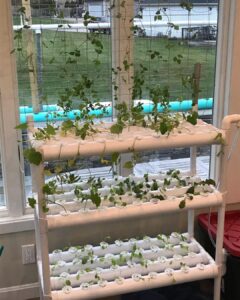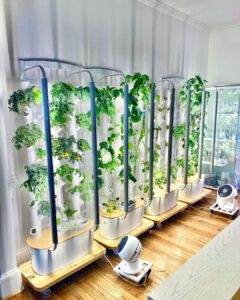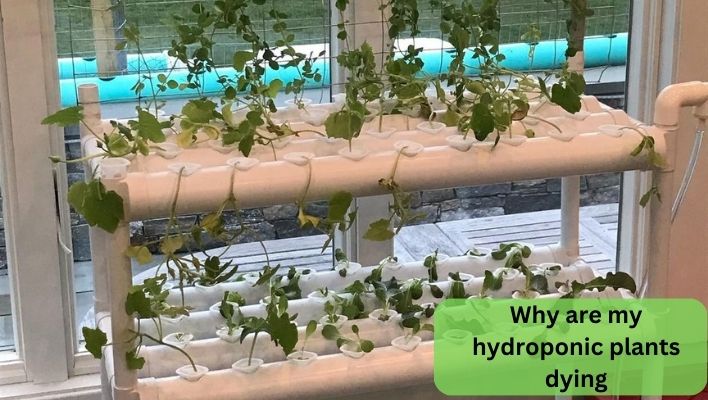Are you feeling frustrated and disheartened by the sight of your hydroponic plants wilting and dying? You’re not alone. Many people are excited to try hydroponics, the method of growing plants without soil, only to be disappointed when their plants don’t survive. But don’t give up just yet.
Hydroponics is a highly efficient and growingly popular way of growing plants without soil, but sometimes things can go wrong, and your plants may start dying.
This can be frustrating for any gardener, especially when you have invested much time, effort, and money into your hydroponic system.
There are many reasons why hydroponic plants die, such as nutrient imbalances, pH level fluctuations, temperature changes, inadequate lighting, and pest infestations.
In this blog post, we will explore some of the most common reasons why hydroponic plants die and how to prevent them from happening.
By understanding the potential causes of your plants’ death, you can take steps to ensure that your hydroponic garden stays healthy and productive. So, let’s dive in and discover why your hydroponic plants might die.
Why Your Hydroponic Plants Are Dying
Below, we explore the possible reasons behind your hydroponic plants’ decline and provide expert tips to revive and maintain their health.
Discover common issues and learn how to ensure optimal growth in your hydroponic system.
- Lack of oxygen
- Overwatering
- Underwatering
- Nutrient imbalances
- pH imbalances
- Temperature fluctuations
- Pest infestations
- Light issues

Hydroponic gardening can be a rewarding experience, but it also requires attention to detail and proper maintenance. In this section, we’ll explore some of the most common causes of hydroponic plant death:
- Lack of Oxygen: Plants in hydroponic systems rely on oxygen to survive. If the roots are not receiving enough oxygen, they can suffocate and die. This can happen if the air pump in your system isn’t working correctly or your water is too warm and can’t hold enough oxygen.
- Overwatering: Overwatering can lead to root rot, killing your plants. It’s important to ensure that your system’s drainage is functioning correctly and keeping your plants dry.
- Underwatering: Just as overwatering can cause issues, underwatering can also be problematic. If the roots aren’t receiving enough water, they can dry out and die.
- Nutrient Imbalances: Plants in hydroponic systems rely on nutrient solutions for their growth. If the nutrient solution is not properly balanced, it can cause problems such as stunted growth, leaf discoloration, or death.
- pH Imbalances: The pH level of your nutrient solution is essential for the health of your plants. If the pH is too high or too low, it can interfere with nutrient uptake, leading to nutrient deficiencies and plant death.
- Temperature Fluctuations: Hydroponic plants need consistent temperatures to thrive. If the temperature in your growing area fluctuates too much, it can stress your plants and cause them to die.
- Pest Infestations: Pests can wreak havoc on your hydroponic system and can be challenging to control. Common pests include spider mites, aphids, and whiteflies.
- Light Issues: Hydroponic plants require the right amount of light to grow. They can become leggy and weak if they don’t receive enough light. Conversely, if they’re receiving too much light, they can become burned and damaged.
How to Identify the Cause of Your Plant Death
- Conduct a visual inspection of your plants.
- Test your nutrient solution.
- Monitor the temperature and humidity of your growing environment.
- Check the pH level of your water.
- Look for signs of pest infestations.
If your hydroponic plants show signs of stress or have died, it’s important to identify the cause before taking corrective action. Here are some steps you can take to identify the cause of your plant’s death:
- Conduct a visual inspection of your plants: Take a close look at your plants to see if there are any visible signs of stress or damage. Look for discoloration, wilting, or unusual growth patterns.
- Test your nutrient solution: Use a TDS (Total Dissolved Solids) meter to test your nutrient solution’s strength. This will help you determine if your plants receive the proper nutrients.
- Monitor the temperature and humidity of your growing environment: Temperature and humidity can significantly impact your plants’ health. Use a thermometer and hygrometer to monitor the conditions in your growing area.
- Check the pH level of your water: Use a pH meter or test kit to check the pH level of your water. This will help you determine if your nutrient solution’s pH is within the appropriate range for your plants.
- Look for signs of pest infestations: Check your plants for signs of pests such as spider mites, aphids, or whiteflies. Look for webbing, tiny insects, or distorted leaves.
By conducting a thorough investigation, you can often identify the cause of your plant’s death and take corrective action to prevent future issues. Incase of salt buildup, here is a detailed guide on how to clean your system of slat buildup.

Identifying the Cause of Plant Death
If your hydroponic plants are dying, it’s essential to identify the cause of the problem before taking any corrective action. In this section, we’ll explore how to identify the cause of your plant’s death:
- Check the Roots: The first step in identifying the cause of plant death is to check the roots. If the roots are brown or slimy, your plants are likely suffering from root rot due to overwatering or lack of oxygen.
- Check the Water Level and Quality: Ensure your water level is high enough and low. Also, ensure that your water is clean and free of debris.
- Check Nutrient Solution: Ensure you use the correct and balanced solution. Nutrient imbalances can cause problems such as nutrient deficiencies, stunted growth, and even death.
- Check pH Level: Ensure your nutrient solution’s pH level is within the correct range. If the pH is too high or too low, it can interfere with nutrient uptake and cause plant death.
- Check Temperature and Humidity: Ensure your plants’ growing environment is within the appropriate temperature and humidity range. Temperature fluctuations and high humidity can cause stress to your plants, leading to death.
- Check for Pests: Inspect your plants for any signs of pest infestations, such as webbing, tiny insects, or leaf damage. Pests can quickly kill your plants if left untreated.
- Check Lighting: Ensure your plants receive the appropriate amount and type of light for their growth stage. Insufficient or excessive lighting can cause damage to your plants and lead to death.
By carefully examining these factors, you can begin to identify the cause of your plant’s death and take corrective action.
Tips for Preventing Plant Death in Your Hydroponic System
Maintain proper oxygen levels Water plants correctly Balance nutrient solutions Monitor pH levels regularly Maintain consistent temperature and humidity levels Implement pest management strategies Provide appropriate light levels.
Now that we’ve explored some common causes of plant death in hydroponic systems and how to identify the issue, let’s discuss some tips for preventing plant death in your hydroponic system.
- Maintain Proper Oxygen Levels: Ensure that your air pump is functioning correctly and that your water is properly aerated. This will help prevent root suffocation and promote healthy plant growth.
- Water Plants Correctly: Avoid overwatering or underwatering your plants. Ensure your system’s drainage functions correctly, and monitor water levels regularly.
- Balance Nutrient Solutions: Ensure your nutrient solution is properly balanced and adjusted to the appropriate strength for your plants’ growth stage.
- Monitor pH Levels Regularly: Regularly check your nutrient solution’s pH level and adjust as needed to ensure your plants receive the proper nutrients.
- Maintain Consistent Temperature and Humidity Levels: Use a thermometer and hygrometer to monitor your growing area’s temperature and humidity levels. Ensure that they remain consistent and within the appropriate range for your plants.
- Implement Pest Management Strategies: Monitor your plants for signs of pests and implement pest management strategies such as biological controls or organic insecticides.
- Provide Appropriate Light Levels: Ensure that your plants receive the appropriate light for their growth stage. Use a timer to ensure your plants receive the proper light daily.
These tips can help prevent plant death in your hydroponic system and promote healthy plant growth. Remember to monitor your system regularly and adjust as needed to ensure optimal plant health.

Troubleshooting Tips for Common Hydroponic Plant Problems
This section will discuss some common problems you may encounter in your hydroponic system and how to troubleshoot them.
- Yellowing Leaves: Yellowing leaves can indicate nutrient deficiencies, such as a lack of nitrogen, magnesium, or iron. Check your nutrient solution and adjust as needed. Yellowing leaves can also be a sign of overwatering or underwatering.
- Brown Spots on Leaves: Brown spots on leaves can signify a fungal or bacterial disease. Remove any affected leaves and treat your plants with an appropriate fungicide or bactericide.
- Wilting Plants: Wilting plants can be a sign of underwatering, overwatering, or root rot. Check your water levels and ensure that your system is properly draining. If root rot is present, you may need to remove affected plants and disinfect your system.
- Slow Growth: Slow growth can be a sign of nutrient deficiencies or inadequate light levels. Check your nutrient solution, adjust as needed, and ensure that your plants receive the appropriate light.
- Nutrient Burn: Nutrient burn occurs when plants receive too many nutrients, leading to burnt leaf tips and edges. Adjust your nutrient solution and reduce the strength as needed.
By troubleshooting these common problems, you can identify and address issues in your hydroponic system before they lead to plant death. Monitor your system regularly and adjust as needed to ensure optimal plant health.
Why are my hydroponic plants dying FAQs?
How often should I change my nutrient solution?
Changing your nutrient solution every two to three weeks is generally recommended.
However, the frequency of nutrient solution changes may vary depending on factors such as plant type, stage of growth, and system size.
Monitoring the quality of your nutrient solution and observing any changes in plant growth can help determine when it needs to be changed.
Can I reuse my nutrient solution?
You can reuse your nutrient solution, but monitoring its quality and adjusting nutrient levels is important.
The nutrient solution can be reused for several cycles, but it may need to be replaced after a certain number of uses or when its quality degrade.
Regularly cleaning and sterilizing your hydroponic system is also important to prevent the buildup of harmful microorganisms.
What’s the ideal temperature range for hydroponic plants?
The ideal temperature range for most hydroponic plants is between 65°F and 80°F (18°C to 27°C).
However, some plants may have specific temperature requirements, so it is important to research the optimal temperature range for your growing plants. Maintaining consistent temperatures to prevent plant stress and damage is also important.
Should I keep my lights on 24/7?
No, it is not necessary to keep your lights on 24/7. Plants need a period of darkness to rest and undergo certain physiological processes.
For most plants, a light cycle of 16-18 hours per day is sufficient for vegetative growth, while a cycle of 12 hours of light and 12 hours of darkness is ideal for flowering and fruiting.
However, the specific light requirements may vary depending on the type of plant being grown.
How often should I check the pH level of my water?
It is recommended to check the pH level of your water at least once a day. pH levels can fluctuate due to plant uptake, nutrient solution changes, and water quality.
Maintaining a consistent pH level within the optimal range for your plants is important to ensure proper nutrient uptake and healthy growth.
Regularly monitoring and adjusting the pH level can prevent nutrient deficiencies and other problems that may affect plant growth.
Conclusion
Hydroponic plant death can be caused by a variety of factors, including lack of oxygen, overwatering, underwatering, nutrient and pH imbalances, temperature fluctuations, pest infestations, and light issues.
You can ensure that your hydroponic plants thrive by identifying the cause of plant death and taking steps to prevent and troubleshoot common problems.
Some tips to prevent hydroponic plant death include:
- Using high-quality water
- Maintaining proper pH levels
- Balancing nutrient solutions
- Monitoring temperature and humidity
- Implementing a pest management strategy
- Regularly cleaning your system
Troubleshooting tips for common hydroponic plant problems include addressing yellowing leaves, brown spots on leaves, wilting plants, slow growth, and nutrient burn.
It is also important to regularly monitor your system and adjust as needed to ensure optimal plant health. Following these tips and being proactive in your hydroponic plant care, you can enjoy a thriving and productive hydroponic garden.
